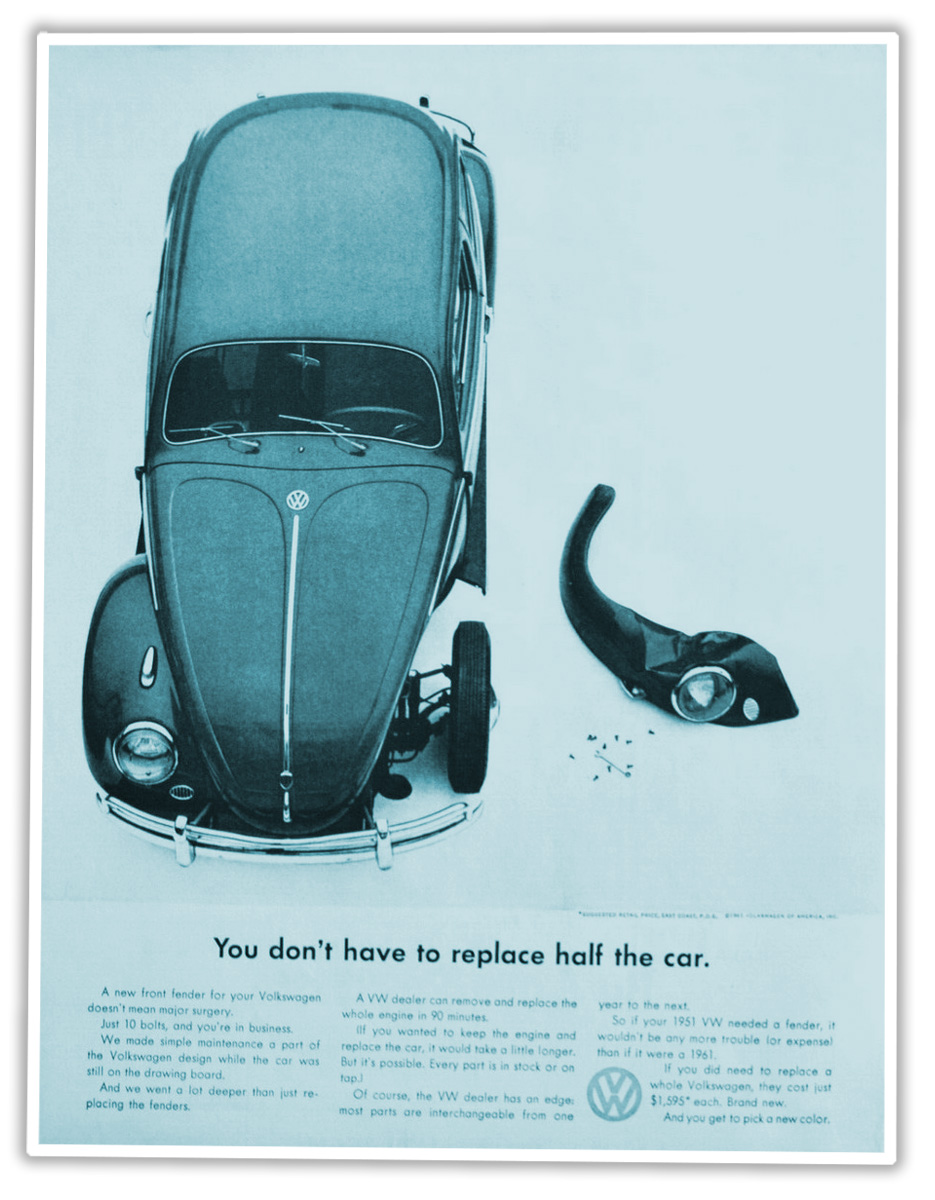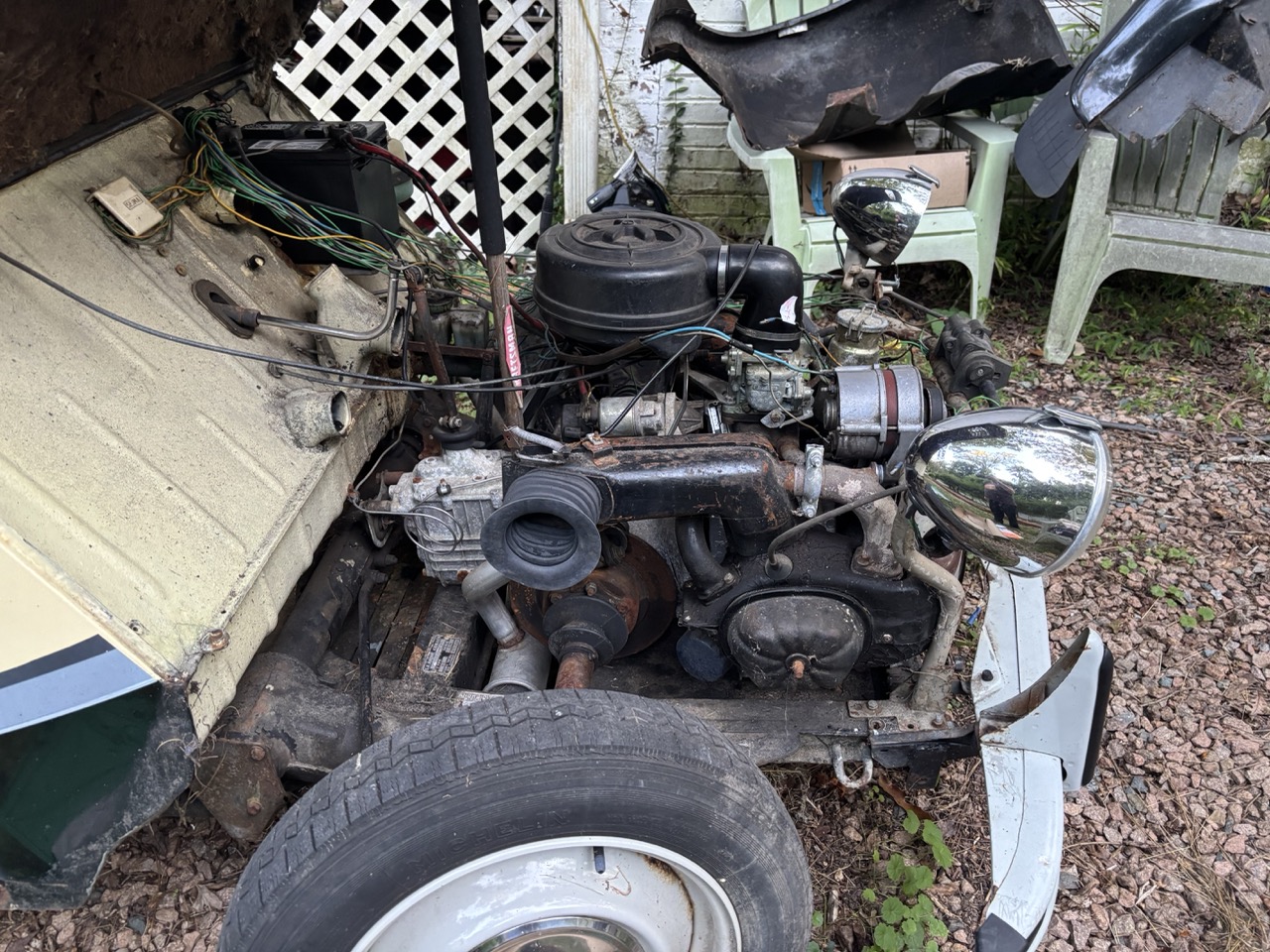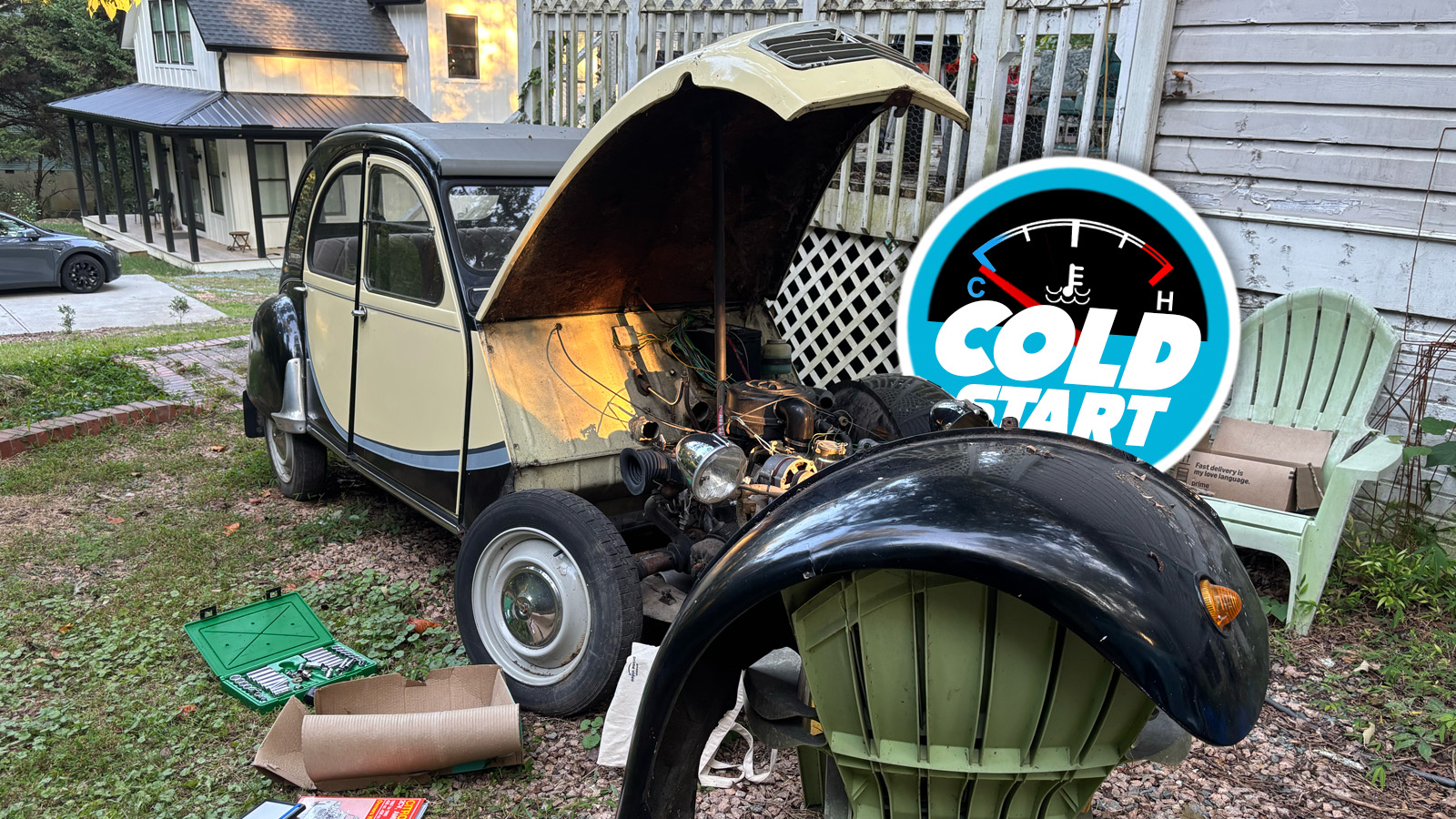I tend to use the term “supercar” in a different way than the common usage, which I feel is limiting. To me, a supercar is a car that has specific traits that perform so much better than the norm, they get elevated into, well, superhood. Most cars we think of as supercars now, like a McLaren P1, for example, are supercars in the categories of speed and acceleration. Remember the Volkswagen XL1? That was a fuel-economy supercar. Mid ’60 Cadillacs may be comfort supercars, A VW Type 3 or 4 could be a packaging supercar, and so on. And I think I found two interconnected ways that my Citroën 2CV is a supercar.
I found these out last night – well, I think I knew of them before, but never experienced them firsthand, and so didn’t fully realize their superhood – when I was getting the car ready so I can work on it tonight, when a local Citroën expert is coming by to help me see if I can finally get this thing started. I feel bad because I haven’t had much time to devote to the car since I got it, but I’m hoping to turn that around. And, of course, get it running.
Anyway, back to the supercar stuff. The two categories of supercar I think the 2CV qualifies for are the coveted Ease of Fender Removal Supercar and the Engine Access Supercar.

Laugh if you must, philistines, but these are a big deal, as far as I’m concerned! If you look at the picture up there, you can see that while the open hood of a 2CV gives decent engine access, it’s only okay. Getting access to the cylinder heads and the valves within on that flat-twin isn’t really easy, as those bulbous fenders block access pretty effectively. I have removed already the triangular-ish filler panels that fit in behind the fenders, and with those gone you do have good access to the transmission and inboard brakes.
But I want more access. And the 2CV expert who is coming by after work today suggested I remove the fenders, so I decided to give that a go. And holy crap, I was delighted.
I’ve removed fenders from a number of cars, including my old Scion xB, a VW Passat, and of course my ’73 VW Beetle, which I had always considered one of the easiest fender removal jobs there was. VW even made ads about this idea:

Just 10 bolts, and it’s off. Pretty easy, right? Well, I soon learned that even that is a colossal chore compared to the 2CV. First of all, the 2CV front fenders are held on with four bolts, not 10, for a 60% reduction in boltage! Holy crap!
And those bolts are shockingly easy to access; in the Beetle, they’re arrayed in an arch on the inner lip of the fender, so you have to get under there, behind the wheel and suspension bits, to access them. Look where they are on the 2CV; here’s bolt one:

It’s right there, outside of the car, by the trailing edge of the fender. Here’s bolt two:

Two is down low, under the hood, just above the bumper bracket. Here’s three:

It’s right above bolt two, just under the headlight mounting bracket. And finally, bolt four:

Four is right by the firewall, nice and easy to access.
That’s it! Those four bolts, and the whole fender lifts off! And, even better is how the fenders are shaped; on the Beetle, the fender is basically C-shaped, and there’s still a lot of body left behind when it’s removed. Same for more modern unibody cars I’ve pulled fenders from, where the fender is really just an outer skin and there’s all that unibody hardware left behind. Not so with the 2CV. The Tin Snail’s fenders are more like whole wheel pockets, and are shaped like this:

See how they have an inner wall? That hole is where fresh air is pulled from the wheel well to feed the heater, if you’re curious. The fenders are kind of like big pita breads that hold the wheel inside, minus the humus (usually).
The result of this setup is that when the fenders are off, there’s pretty much no body left in place in that area, and access to the engine becomes incredibly good. I mean, look:

Look at that! You can get to pretty much everything there: cylinder head, CV joint, brakes, axles, fuel system, exhaust system, everything is right there.
When so much of working on a car is being in uncomfortable positions and shoving your hands into impossibly tight and greasy alleys between scrape-y and sharp-edged parts, this feels like a dream.

The whole front part of the body is just five parts: two fenders, two of those side filler panels, and the hood. That’s it. Take those off and you’ve got a car with an entirely exposed drivetrain.

Of course, the wiring is still a mess, but at least I can get to everything easily. I hope I can get this thing running tonight.
Also, with the hood down and the fenders off, I think it looks pretty tough, in a kind of Maxmaxian way:

At 5:30 the 2CV expert shows up. Wish me luck!








Please be careful where you put the fenders and how you lay them down. They scratch and bend easily if you are not careful and walk them over, or walk past them with something in your hands. If they are on the car, your mind and body are trained to behave when you walk around the car. If they are loose, you treat them as ‘just objects’.
I’m sure I could find some willing local gear heads who’d be excited to pop over to CH and give you a hand, Torch. Just say the word.
Your wiring is a nightmare!! And there is so much of it. Its like someone gave every component its own battery feed & ground.
I have a 1976 2CV, and it had a wire resting on the heater box when I bought it. The insulation melted, but luckily I noticed it before it shorted. All of your wiring seems to be hanging against the heater box! And the wires dangling near the axle and in front of the fan are terrifying to me.
Be careful to make sure the shifter and throttle linkages are clear of interference. My shifter was slowly cutting into the wire from the starter to the battery, and my throttle linkage was dragging against the choke cable, making for a lurching power delivery.
I wish I was there to play!! Here in Seattle, I’m planning to pull the fenders on mine this weekend for an oil change and general going through. 🙂
No electrical/wiring issue is too challenging for Jason “Chainsaw” Torchinsky.
And you can sit on the tire whilst wrenching!
BTW, the shadow on the bottom right of the ‘bolt four’ picture looks like some mutant insectoid is watching you.
Anywho, more cars should allow easy access like this.
With the hood and no fenders, it gives ’32 Ford hotrod vibes.
Correction: The 1st gen Honda Insight is the Supercar of MPG. The VW XL1 is a joke by comparison; over 100k sticker, PLASTIC WINDOWS, basically a toy for rich people and a publicity stunt. I’ve still never seen one in real life, meanwhile you can get the MPG supercar Insight for 3-5k and drive it in any weather, even up mountain passes in snowy conditions with the right tires.
Torch I wish I lived near you, I want to help rewire that thing so bad. Pretty jealous you picked this up, it looks like a fantastic classic you can put miles on. Once you get it dialed this should be your daily from now on.
you’re missing the point. A supercar is supposed to be unattainable.
Seeing the front end stripped of all the bodywork reminds me of changing a windshield wiper fuse on an Audi.
I dunno……on a Spitfire all you do is tip the hood forward and it’s all there…… no need to remove any fenders at all……
OTOH, one can only work on the Spitfire’s engine from the sides. All-around access is seriously nice, that’s for sure!
Plus you still have to remove the hood assembly if you want to take out the engine; seems like the Spitfire’s hood assembly & associated bits would be a real PITA to remove.
So the 2CV still reigns supreme 🙂
There really isn’t any other direction you need to access anything from on a Spitfire. Everything is on the sides other than the valve cover, and that is held on with two nuts. Even the oil drain plug is on the side of the oil pan, and accessible with the car on the ground.
It’s three bolts and a couple of electrical connections for the lights to remove a Spitfire hood – plus a couple bolts for the hinge covers, I suppose.. It is big and awkward though. Not particularly heavy, but it’s a two person job for sure.
You absolutely can remove the engine with just the hood open – but it is easier to take it off. Done it both ways in the almost 30 years I have owned mine.
A Spitfire is probably one of few cars where it is quicker and easier to remove the engine than the transmission though. The transmission has to come out of the inside of the car, and even if you remove it attached to the engine (don’t, though removing the engine first works), the whole center of the interior has to come out to detach everything. PITA, that. I can have the engine on the floor in about a half an hour.
Supercar. Most “Supercars” are useless display items. Much like Ferris Buhler’s friend’s dad. “He just wipes it with a diaper.” A friend of mine’s dad gave him an Aston Martin for his 50’th birthday. Nice dad, one would think, more to that story and not relevant. After he had it a few days, he realized there was really nothing he could actually do with this car. Drive it to the market? Go to the airport with it? It was Miami, driving and parking it anywhere ment it would disappear like a kiddy show’s magician’s coin. Finally he drove it to the post office to mail a package. That should be safe, only inside of five minutes. Nope, he comes out, only to watch some cow in an SUV back into it. I have no idea why they are actually labeled as “sports” cars, since you really cannot do any sport short of badminton with them. You can’t put much more than a sandwich in the trunk, if they had one, or in the backseat, should one actually be present. What is the point to them. Their capability means felony in almost any jurisdiction. So the 2CV is more useful than any “Supercar.”
Not sure if all 2CVs have this feature but at least some had their hood with a hinge arrangement that fit inside a groove so you could just open the hood up and slide the hood sideways to remove the hood. Pretty cool!
At least the early 2CVs had doors with a similar hinge arrangement where you could just open the doors and slide the doors up to remove them (not sure about later 2CVs…)
Yeah, I’m a bit of a 2CV-head (& Citroën-head) but with a *lot* of gaps in my knowledge, some of which I’m filling in by reading posts like this, lol. But I daresay I’m not the only one awaiting with a lil’ bit of a bated breath to read about what the Citroën expert has to say upon their arrival at 5:30 (17:30 to use the 24-hour clock commonly used in Europe including France, mais bien sûr! Alas, haven’t found a conversion chart for the metric clock which methinks would also be pretty apt for working on a French car, lol.)
Its not a hinge arrangement – there are no actual hinges. Its just two pieces of sheet metal folded over and slid into each other. I would post pictures of my 2CVs hood “hinge” here if I could.
Yeah, one could ontologically or semantically say that those two pieces of sheet metal folded over and slid into each other indeed do constitute a hinge arrangement. After all, what is a hinge but simply something that allows something to swing around something else in the act of opening or closing? Could be something as simple as a piece of fabric glued to two pieces of cardboard, e.g. the spine of a simple book or the door on a child’s cardboard model house or castle, or something as complex as, say, a double parallel (double kinematic) opening system, e.g. the door hinges on a Renault Avantime.
Yeah, ontology ‘n’ semantics can be fun 🙂
The Lane Motor Museum has an old 2CV that visitors can sit inside for pictures (though that can be a little problematic because then some people think they can just touch the other cars willy-nilly, egad) where people without 2CVs of their own can see for themselves how the hood & doors are hinged. Mighty cool!
The museum also has a *new* 2CV, albeit mostly sans corps, to demonstrate how many new parts are still available today for the 2CV; in fact, Jason has made a video of himself driving that 2CV sans corps.
In my mind, a hinge needs to have some attachment to both panels. But perhaps my concept of a physical form should take a back seat to function… perhaps a constrained fulcrum point is all that is needed.
I discovered the sliding hood while working on my car in a park just few hours after buying it. I was looking for the cause of clunking noise. There was no hood prop, and I was holding the hood up with my shoulder. As I leaned forward – the hood suddenly slid sideways maybe 2 feet. For a moment I was sure I had broken the hood off!
Bolt 1 looks like it’s held by thoughts and prayers!
This message brought to you by the NRA – No Rusty Automobiles.
how are there so many wires!?!
Torch can i come over and play citroen legos w you
Gotta say that I’m impressed. Impressed that Torch fashioned a prop rod out of a garden hoe handle.
Should have been a chainsaw extension handle.
Open wheel racing.
Slide the front hood sideways out/off, so it doesn’t fall on your heads while working on the engine. Good luck!
I’ve been saying this for a long time: high performance is a relative term. A Lamborghini (we can skip defining which model) is high performance, nobody argues when you say it. A Toyota Corolla is high performance and runs dizzying rings around a Lamborghini, and you have to clarify things.
What performance we’re talking about is the important bit. Context matters. A Lamborghini is high performance in the general sense of go-fast, turn-sharp, get there first performance. A Corolla leaves it far, far behind just rolling out the showroom door, outperforming any Lambo – or Ferrari, or Maserati, or lots of other things – on miles per dollar, hours driven vs. hours maintained, etc.
The Citroen was designed from the outset to be cheap to use and cheap to keep. However you want to measure that: hours, francs, milliliters of sweat, the 2CV rewards every bit of equity expended on it with relentless utility.
Star for “relentless utility.”
It’s like when people say “this is a quality product”. What quality are they referring to?
My kids’ response when I tell them to behave: “This IS behavior!”
My little brother’s response to that when we were kids was “I am being have!”
One of my engineering professors defined quality as “something your customer will pay for”. If your customer won’t spend more money on it, or choose you over your competitor for it it’s not quality. I always like that definition since it really gets down to the “why do we care”. That doesn’t mean there could isn’t other benefits to it (cost savings, efficiency, ease of production, etc.), but it’s important to know why you’re doing something.
Sometimes when someone describes to me how a day didn’t break their way, I tell them they’re just lucky.
When they give me the confused puppy face, I explain: “I didn’t say the luck was good.”
Reminds me of Terry Pratchett:
That minimalist approach made them a death trap. I do not recommend driving it on a highway, can be crushed by the draft of an eighteen-wheeler. But my point is: to save parts and bolts, Citroen placed half of the steering rack directly on the firewall. With two flimsy bolts. Sooner or later, the contraception will come loose, get worn out the wrong way, and you will find yourself trying to steer to the right without success. It still will steer to the left, making everything more fun.
Just hope your steering gets loose in a roundabout.
The steering rack is bolted to the frame rails…it’s easy to see.
>Sooner or later, the contraception will come loose…
and then it starts going Pepe Le Pew on all your other cars.
“I am piercing you with the ack-ack of love, my sweet!”
I too hate when my cars condom gets loose !
The 2CV was never designed for highway use. I tip my hat in frank amazement at anyone bold enough to point one of these rolling compost bins onto the on ramp and uncork all 29 horsepower. That takes guts, a certain je ne sais quoi that can only be properly saluted with a lit Gauloise and a joie de vivre unmatched by the teeming hordes in their RAV4s*.
The 2CV was supposed to be farm-to-town and back again. It was a creature born from the ashes of war where the highways had been bombed to shit and all the roads that were left were small and rough, and rural people needed to get things done. Citroen absolutely could build powerful, sleek cruisers that would be perfectly at home on American highways – looking at you, Traction Avant – but the 2CV was conceived in the interwar period, and really had a market that needed it in the post-WWII market that catapulted into instant stardom, small and modest though that star may have been.
*Don’t @ me, I drive a RAV4.
Seeing the minimalist approach to fasteners and then seeing the hood off, I started to picture a Baja-bug-style engine protector, repurposed to protect the 2CV. It would require significant modification (and might be easier to build from scratch) but it’s an interesting concept.
If you get a chance, please ask the 2CV expert if such a thing would make sense. 🙂
The 2CV Sahara circumvented the need for an engine protector by having two engines
Why would it have to make sense? This is Torch we’re talking about!
If there is one person out there that is really, really pulling for this 2CV to start tonight it is this guy!
It’s like seeing an ex that has moved on, but in a good way.
Wicked pumped for you, bud!
Another is probably the next door neighbor in the cookie cutter PS2 house.
Eat your heart out, Wrangler owners.
From the same manufacturer, the rear fender on the ID/DS models comes off with ONE bolt, so you can change the skirted rear tire.
Also the front fenders also come off with little effort. A couple of screws and some wires and hoses to detach and you’re done.
That wiring photo makes my head hurt.
Plus, you finally found a good use for those cheap plastic patio chairs.
Look at you, slacking away in here while Matt slaves over a hot Showdown 😀
Hope you’re doing well!
Better, thank you. Home now, with a cat purring next to me. Still a lot of convalescing to do, but the hard part’s over.
Fingers crossed, etc. for you – glad you’re home!
The cat will definitely help, but if confronted will deny everything 🙂
Don’t “holy grail” another term.
Eventually there will be a holy grail of holy grail terms. Yo dawg.
Holy grails are about as unique as Presidential Pardons and Presidential Medals of Honour these days.